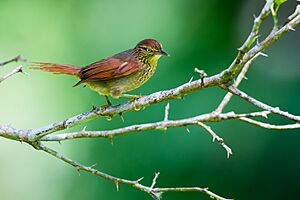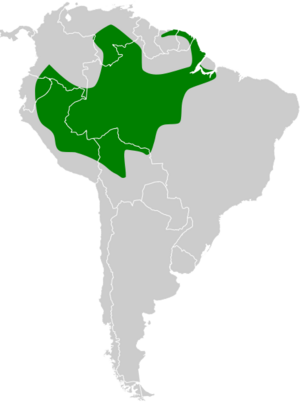Speckled spinetail facts for kids
Quick facts for kids Speckled spinetail |
|
|---|---|
 |
|
| Conservation status | |
| Scientific classification | |
| Genus: |
Thripophaga
|
| Species: |
gutturata
|
 |
|
| Synonyms | |
|
|
The speckled spinetail (Thripophaga gutturata) is a small bird that belongs to the ovenbird family, called Furnariidae. It's found in several countries in South America, including Bolivia, Brazil, Colombia, Ecuador, French Guiana, Peru, Suriname, and Venezuela.
Contents
About Its Name
The speckled spinetail's scientific name is Thripophaga gutturata. For a while, scientists thought it belonged to a different group of birds called Cranioleuca. But after a study in 2011, they decided it fit better with the Thripophaga group. Many bird groups around the world now use this new name.
What Does It Look Like?
The speckled spinetail is a small bird, about 13 to 15 centimeters (5 to 6 inches) long. It weighs around 13 to 17 grams (0.46 to 0.60 ounces), which is about as much as a few quarters.
It has a brownish-yellow stripe above its eye. Its cheeks and ear areas are also brownish-yellow with dark speckles. The top of its head is a dark reddish-brown, which turns dark brown on its back. The lower part of its back and tail feathers are a richer, reddish-brown color. Even though it's called a "spinetail," its tail feathers are actually rounded, not spiky.
Its wings are dark reddish-brown. The underside of its chin is a dull yellow. Its throat and chest are a yellowish-brown with dark brown triangle-shaped spots. The rest of its belly and underside are also yellowish-brown, but with lighter spots. Its eyes can be pale yellow or brown. Its beak is dark gray or black on top and lighter gray or blue-gray on the bottom. Its legs and feet are olive or brownish-yellow.
Young speckled spinetails look a bit different. They have a brown head instead of reddish-brown, and their back is more grayish-olive. They also have very few or no spots on their underside.
Where Does It Live?
This bird lives in a large area of the Amazon Basin in South America. You can find it in places like southeastern Colombia, southern Venezuela, and much of western Amazonian Brazil.
It likes to live in lowland evergreen forests. It especially prefers várzea forests, which are forests that get flooded by rivers. It also lives in areas where these flooded forests meet drier land. Sometimes, it can be found in terra firme forests, which are higher and don't flood. This bird really likes areas with lots of thick vines. It usually lives below 400 meters (1,300 feet) in elevation, but sometimes it can be found as high as 1,100 meters (3,600 feet).
Behavior
Movement
The speckled spinetail stays in the same area all year round. It does not migrate to other places.
What It Eats
This bird mainly eats arthropods, which are creatures like insects and spiders. It especially likes cockroaches and "true bugs." It also eats other insects and spiders it finds.
Speckled spinetails usually look for food alone or in pairs. They often join groups of different bird species that are foraging together. They usually search for food in the middle and upper parts of the forest trees. They are very good at climbing and hopping up tree trunks and along branches. They often find food in clumps of dead leaves. They also poke around and pick insects off live plants, tree bark, moss, epiphytes (plants that grow on other plants), and palm leaves.
Reproduction and Life Cycle
Scientists don't know a lot about the speckled spinetail's breeding habits. In Peru, it seems they start building nests around August. Their nest is shaped like a cone made of moss. It gets narrower at the bottom, where there's an entrance hole. The nest hangs down from a tree branch.
It's believed that these birds stay with one partner for life. Beyond that, not much else is known about how they raise their young.
What It Sounds Like
The speckled spinetail has a few different songs. One song is a shaky, descending trill that starts with a note, sounding like tch-t-t-t-t-t-t-t-t-t-t. Another song is a short series of high, sharp notes, like 'tsee-tsee-tsee-tsee-tsee-tsee'. When it's alarmed, it makes a short, low rattling sound.
How Many Are There?
The IUCN (International Union for Conservation of Nature) has looked at the speckled spinetail and decided it is a species of "Least Concern." This means they are not worried about it becoming endangered anytime soon.
This bird lives across a very large area. Even though we don't know exactly how many speckled spinetails there are, scientists believe their population is stable. There are no big threats that could harm them right now. While they might be rare in some parts of their range, they are quite common in the central areas. They can sometimes be hard to spot, so people might not realize how many there are. This bird also lives in at least one protected area in Peru.


